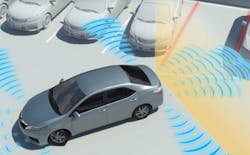Automotive paint can have both direct and indirect impacts on Advanced Driver-Assisted Systems (ADAS), depending on its properties and how it interacts with the various components of these systems. Repairing vehicles equipped with ADAS is a relatively new area for collision repair facilities and can yield unexpected negative consequences if the OEM repair instructions are not closely followed. It is crucial for repairers to adhere to OEM guidelines and recommendations when working on vehicles featuring ADAS.
In today's modern vehicles, advanced technologies are more prevalent than ever before, relying on radar, sensors, cameras, and other devices to gather data that enhances both vehicle safety and convenience for its occupants. Whether these sensors are part of park distance control, active park assist, adaptive cruise control, or other vehicle operations, the proper functioning of these systems may be compromised by post-collision repairs.
When the repair area involves ADAS equipment, the repairer should first consult the OEM for specific guidance and special considerations related to the repair. Neglecting to adhere to the appropriate repair and painting procedures can result in costly rework or, more critically, compromise the safety and integrity of the affected system.
One important consideration for repairs involving ADAS has to do with the vehicle color. It is important to be aware that certain refinish color formulas may contain levels of pigments that can disrupt radar signals, potentially impairing the function of radar devices after repair and painting. In areas where radar is emitted and received (radar zones), it is vital for the repairer to fully understand the OEM procedures and guidelines, and to adhere to them without variation.
Vehicle manufacturers have identified specific colors that may negatively impact radar performance when applied in a radar zone during refinish operations. When requested by the OEM, paint manufacturers develop new formulas for these colors. These reformulated colors are then subjected to specialized testing by the OEM to ensure compatibility with the technology before receiving approval. These radar-compatible color formulas must be used when painting in a radar zone, and it is crucial to mix them accurately and without deviation. Straying from the formula could result in a color that negatively affects the signal, causing a malfunction.
Color formula approval and accurate mixing aren’t the only things to consider when repairing vehicles with ADAS. OEMs provide their networks with comprehensive guidelines and precise repair standards regarding their technologies, specifying what can and cannot be repaired and which repair methods are permissible. For instance, coatings film build is typically a critical consideration when dealing with radar. Manufacturers often provide parameters for film build – even for specific paint system layers such as the undercoat, basecoat, and clearcoat. Additionally, body fillers, putties, plastic welds, and staples are all prohibited in radar zones. Even sanding and buffing procedures in these areas may need to be considered. It is essential to be fully informed and follow the specific OEM procedures for repairs that include a radar zone to ensure no unexpected issues arise.
Another often overlooked factor is the uniformity of coatings applied in the radar zone. Consistent and uniform paint layers are often required for signals to transmit through the substrate without unexpected reflection, deflection, or absorption. Blending the basecoat color or other parts of the applied paint system in the radar zone is commonly prohibited. Always reference and fully understand the specific OEM repair manual procedures for the vehicle being repaired – they are not all the same and some may even vary by vehicle model!
Keep in mind that technological advancements evolve rapidly, and not every ADAS repair consideration has been discussed here. Ensure that you have the most up-to-date information from the vehicle manufacturer as it is imperative to obtain all relevant repair specifications and methods before undertaking repairs within radar and other sensor areas. The responsibility lies with the repairer to ensure that the sensors and other devices associated with ADAS retain their functionality as designed by the manufacturer and to maintain the OEM-designed vehicle safety and integrity.





